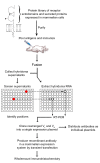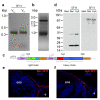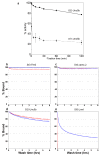A rapid and scalable method for selecting recombinant mouse monoclonal antibodies
- PMID: 20525357
- PMCID: PMC2898661
- DOI: 10.1186/1741-7007-8-76
A rapid and scalable method for selecting recombinant mouse monoclonal antibodies
Abstract
Background: Monoclonal antibodies with high affinity and selectivity that work on wholemount fixed tissues are valuable reagents to the cell and developmental biologist, and yet isolating them remains a long and unpredictable process. Here we report a rapid and scalable method to select and express recombinant mouse monoclonal antibodies that are essentially equivalent to those secreted by parental IgG-isotype hybridomas.
Results: Increased throughput was achieved by immunizing mice with pools of antigens and cloning - from small numbers of hybridoma cells - the functionally rearranged light and heavy chains into a single expression plasmid. By immunizing with the ectodomains of zebrafish cell surface receptor proteins expressed in mammalian cells and screening for formalin-resistant epitopes, we selected antibodies that gave expected staining patterns on wholemount fixed zebrafish embryos.
Conclusions: This method can be used to quickly select several high quality monoclonal antibodies from a single immunized mouse and facilitates their distribution using plasmids.
Figures




References
Publication types
MeSH terms
Substances
Grants and funding
LinkOut - more resources
Full Text Sources
Other Literature Sources
Molecular Biology Databases
Research Materials

